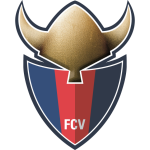Top Qs
Timeline
Chat
Perspective
FC Vestsjælland
Football club in Slagelse, Denmark, 2008–2015 From Wikipedia, the free encyclopedia
Remove ads
FC Vestsjælland, also known as FCV Vikings, was a professional Danish association football club that played in the Danish 1st Division until its bankruptcy on 9 December 2015.[1] Where it was force relegated to the Sjællandserie but Slagelse B&I already had a team there. They played their home matches at Harboe Arena Slagelse in Slagelse, which has a capacity of 10,000 (3,300 seats). The club was a elite merger between Slagelse B&I, Vemmelev Fodbold and 7 other local football clubs.
You can help expand this article with text translated from the corresponding article in Danish. (May 2025) Click [show] for important translation instructions.
|
Remove ads
History
FC Vestsjælland was founded in January 2008 as the professional structure comprising the first team of the mother club, Slagelse B&I (SBI). On 9 December 2015, FC Vestsjælland was declared bankrupt.[2]
Colours and badge
Summarize
Perspective

Waiting until pre-season training in the summer of 2008, Vestsjælland unveiled the new club's official kit.[3] With the launch of the superstructure project, it was decided to preserve and continue with the traditional colors of Slagelse B&I, red and blue. The overall design remain largely unchanged throughout their history featuring a red shirt, blue shorts, and red socks. The club did however break from that tradition with the kits that they would wear away from home, beginning with a nearly all-black design, only accented with small amounts of white markings.
Club management worked for some time before the event to ensure that a new badge would meet three points which were seen as imperative, including: the need to contain the club colours (red and blue), the need to be easily recognisable, and the need to be unique by comparison to other clubs in the football world. A new badge for the club was unveiled on 2 August 2008 as the club held FC Vestsjælland Dagen (lit. 'FC West Zealand Day') within the city of Slagelse, with several hundred people in attendance.[4] The badge was publicly revealed as it was unfurled from the top of a local Sparekassen Sjælland, one of the club's sponsors.[4]
The final design was based on the club's regional and national location, where the Viking Age has a cultural historical role with the previously strategically placed military Viking castle, Trelleborg near Slagelse.[4] The club logo consists of two basic elements: a triangular shield containing three vertical stripes in the club colours, and a stylized horned gold helmet with nose protection akin to helmets worn by vikings. With the abbreviation of "FCV" in white at the bottom, the crest is encircled by a white and black coloured edge, allowing it to distinguish itself from surrounding elements.[4]
The club also continued with the trend in the form of their supporter group "Slagelse Red Vikings" and the club mascot known as "Hjalte", which frequently appeared at home games.[5] Utilizing their parent club's motto of "the Team of the Region", the club badge and kits made their official debut in a match the following week on 9 August 2008 in a 2nd Division match against HIK.[6]
Remove ads
Honours
- Danish Cup:
- Runners-up (1): 2014–15
Kit and sponsoring
Kit manufacturer and sponsoring for FCV.
First kit evolution
The club's colors are generated from the club's logo which are red and blue.
|
2012–13
|
2013–14
|
2014–15
|
Remove ads
Staff
Management
- Director of Football: Jacob "Gaxe" Gregersen[9]
Sports
- Goalkeeping Coach: Henrik Zarp[10]
- Talent Manager U12 – U19: Jeppe Tengbjerg[11]
- Head Coach U17: Mohammed Salem[12]
Medical
- Mental Coach: Renè Nielsen[13]
Last squad
- The squad given here is made up of the players registered to the club on the date of FC Vestsjælland's bankruptcy on 9 December 2015.[14]
Note: Flags indicate national team as defined under FIFA eligibility rules; some limited exceptions apply. Players may hold more than one non-FIFA nationality.
Remove ads
Managerial history
- Win percentage is rounded to two decimal places.
Remove ads
Seasons
Summarize
Perspective
|
|
| Winners | Runners-up | Promoted | Relegated |
Remove ads
Player of the season
- 2014–15:
 Rasmus Festersen[46]
Rasmus Festersen[46]
Affiliated club(s)
The following club was affiliated with FC Vestsjælland:
 Shillong Lajong (2012–2014)[47][48]
Shillong Lajong (2012–2014)[47][48]
References
External links
Wikiwand - on
Seamless Wikipedia browsing. On steroids.
Remove ads

